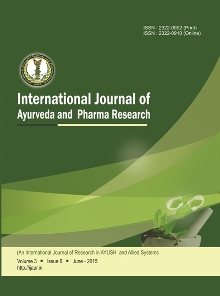Efficacy of Virechana Karma in Gambheer Vatarakta wsr to Psoriatic Arthritis
Abstract
Gambheer Vatarakta, a severe manifestation of Vatarakta, a condition where there is an imbalance of the Vata and Rakta doshas. Gambheer Vatarakta is characterized by Syavthu, Stabdhata, Arti, Shyava-tamra Twaka, Daha, Toda, Sphurana, Paka in joints, resembling the symptoms observed in psoriatic arthritis. The term Gambheer translates to severe or profound reflecting the intensity of the condition. Aim: The study seeks to evaluate the impact of Virechana Karma in Gambheer Vatarakta with special reference to psoriatic arthritis, symptoms including pain, swelling, and joint function, as well as its influence on the overall inflammatory and Dosha balance. Methods: A detailed case study was conducted on a 26-year-old female patient diagnosed with Gambheer Vatarakta. The patient underwent with a procedure of Virechana Karma, following a preparatory phase of Snehana (oleation) and Swedana (sudation). Clinical assessments were performed before and after the treatment regimen, including detailed symptom evaluations and laboratory tests to monitor changes in inflammatory markers and Dosha imbalances. Results: The Virechana Karma resulted in significant reduction in joint pain, swelling, and skin lesions. The patient experienced improved joint mobility and overall functional capacity. Laboratory tests showed a notable decrease and more balanced Dosha levels. The patient reported decreased severity of psoriatic symptoms, indicating an improvement in both the arthritic and psoriatic components of the condition. Conclusion: This case study demonstrates that Virechana Karma can be an effective treatment for managing Gambheer Vatarakta in context of psoriatic arthritis. The therapeutic purgation led to significant relief and improved functional outcomes. The study supports integration of Virechana Karma in treatment protocols for complex cases involving chronic inflammatory arthritis and suggests further research to confirm its broader efficacy and potential benefits.
Copyright (c) 2025 International Journal of Ayurveda and Pharma Research

This work is licensed under a Creative Commons Attribution-NonCommercial-ShareAlike 4.0 International License.


